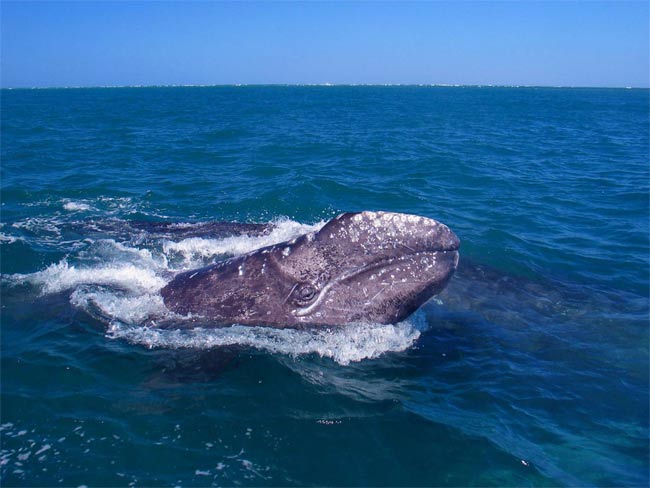Gray Whales Still Not Recovered From 19th Century Whaling

Nearly 100,000 or more gray whales once thrived in the Pacific Ocean, greatly outnumbering today's population, a new study suggests.
The sea giants, which can reach a length of 50 feet (15 meters) and tip the scales at 35 tons (32,000 kilograms), were hunted nearly to extinction by whalers in the late 19th century.
By 1994, the gray whale population in the eastern north Pacific was considered "fully recovered," and the federal government removed it from the U.S. Endangered Species List. (The western north Pacific gray whale population is still struggling with just about 100 individuals remaining today.)
But new research suggests the eastern gray whales are still having a tough time.
"It suggests the gray whale population we have now isn't fully recovered from whaling," said study team member Stephen Palumbi of Stanford University's Hopkins Marine Station. "If the ocean was able to support them the way it used to, then the population would continue to grow."
Population dive
S. Elizabeth Alter, also of the Hopkins Marine Station, and her colleagues compared genetic variability among 42 eastern gray whales. Both the western and eastern populations are so similar genetically, those figures allowed the team to back-calculate the total historical population, Palumbi said.
Sign up for the Live Science daily newsletter now
Get the world’s most fascinating discoveries delivered straight to your inbox.
"A small population becomes inbred over time and that strips away the genetic variation," Palumbi told LiveScience. "As a consequence, a small population has very little genetic variation, and a big population has a lot more."
Since these DNA changes don't show up for years and years, the current variability indicates the past population size, which they calculated at 76,000 to 118,000 animals (average of 96,000).
Bounty-less seas
The finding, published in the Sept. 10 issue of the Proceedings of the National Academy of Sciences, has implications for current conservation efforts of the 22,000 eastern gray whales or so in the planet's seas.
The eastern gray whale population was growing in the 1990s, and then in 1999 and 2000, it hit a "bump," and several whales reportedly washed ashore emaciated. The whales then seemed to recover somewhat, until this year when scientists observed signs of starvation.
Scientists had assumed the starvation was due to the whale population reaching its historical ecological limits. But if the new estimate is correct, the ocean habitat should be bountiful enough to support many more gray whales.
The starving could be a consequence of a reported shift in the Arctic ecosystem, in which the whales' main food supply (crustaceans) has been pushed out due to warming waters, the scientists suggest.
- VIDEO: Gray Whales Take a Dive
- Top 10 Surprising Results of Global Warming
- IMAGE GALLERY: The World's Biggest Beasts
Jeanna Bryner is managing editor of Scientific American. Previously she was editor in chief of Live Science and, prior to that, an editor at Scholastic's Science World magazine. Bryner has an English degree from Salisbury University, a master's degree in biogeochemistry and environmental sciences from the University of Maryland and a graduate science journalism degree from New York University. She has worked as a biologist in Florida, where she monitored wetlands and did field surveys for endangered species, including the gorgeous Florida Scrub Jay. She also received an ocean sciences journalism fellowship from the Woods Hole Oceanographic Institution. She is a firm believer that science is for everyone and that just about everything can be viewed through the lens of science.









